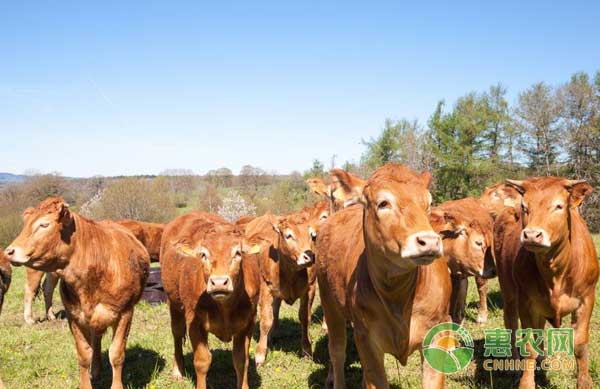Characteristics of common cattle diseases and methods of prevention
It is very common for cattle to become sick during the breeding process of beef cattle due to weather or improper feeding, but it also affects the quality of beef cattle and the quality of dairy products. Even some zoonotic diseases will give human health. Bring threats. Therefore, farmers must master some common characteristics and prevention methods of cattle disease, so that cattle can grow healthily and ensure the safety of cattle products. First, the characteristics of cattle disease 1, frequent occurrences of difficult diseases Multi-pathogenic mixing is the main case of bovine disease and the bacteria and viruses in bovine disease have been constantly upgrading and changing. This is the main reason for this phenomenon and it also increases the difficulty of prevention and treatment of cattle diseases. At present, it is known that there are more than 20 kinds of pathogens such as fungi and bacteria, which are the main pathogens causing endometritis in cattle. With the increasing number of cattle, there is no drug to cure it, and the new type of bovine disease will increase the difficulty of diagnosis and treatment. . 2. A wide variety of cattle diseases The spread of some viruses or bacteria infected with bovine diseases can be carried out in mammals, thus seriously threatening the health of the breeder. At this time, effective prevention and control of cattle diseases is not only to make the economy not suffer, but also to ensure the health of the farmers. Among them, tuberculosis, which is the most susceptible to infection, should be the focus of prevention and treatment. 3, human and animal cross infection At present, tuberculosis, Brucella, etc. are pathogenic bacteria that can cause cross-infection of humans and animals. After cross-infection, the human body health is seriously threatened. The larger the breeding scale, the more tuberculosis occurs. At present, there are two countries in the world that are the most serious countries with tuberculosis, and China is one of them. According to incomplete statistics, about 13% of patients with tuberculosis are mainly from Mycobacterium bovis, which shows that cross-propagation is the cause. An important cause of tuberculosis. Second, common cattle disease 1. Yak diarrhea The main reason for the occurrence of yak diarrhea is that the calf is invaded by bacteria or rotavirus, such as enterotoxin-producing Escherichia coli, Campylobacter, etc., due to the growth environment after the calf is born. Therefore, the farmer should pay special attention to disinfecting the growth environment of the newly born yak and maintaining good hygiene to improve the survival rate of the burdock. 2, bovine tuberculosis Strong contagion is the main feature of bovine tuberculosis. This disease will not only spread between livestock but also to humans. Mycobacterium tuberculosis is the main cause of tuberculosis, causing variability of living organ tissues and calcification. Mainly realized as low-grade fever and cough. Mycobacterium tuberculosis has a wide transmission route such as reproductive organs and respiratory tract. Although tuberculosis has been relatively stable under the strong control of tuberculosis in China, because of the strong environmental adaptability of tubercle bacilli, farmers should pay attention to the ventilation and sun exposure time of the breeding site during the process of breeding. The occurrence of bovine tuberculosis. 3, bloating The feed eaten by cattle is the main cause of bloating. If the cow eats too much of the easily swellable or easily fermented feed, it will rapidly ferment in the rumen of the cow and then produce a large amount of gas to produce bloating. The main manifestation of bovine bloating is that the abdomen of the cow is obviously swollen, the food intake begins to decrease, and there is no appetite, restlessness, and difficulty in breathing. Once the farmer discovers that the cow has the above symptoms, he should immediately take effective measures to treat it. For example, let the cow slowly discharge the gas from the body and depressurize the cow to remove harmful substances from the rumen of the cow. 4, bovine leukemia The incidence and mortality of bovine leukemia are extremely high and the distribution range is wide. Almost all areas where cattle are raised have bovine leukemia. Bovine chronic neoplastic disease is the main feature of bovine leukemia. The source of bovine leukemia virus infection is its main pathogen. Bovine and other livestock with leukemia are the source of infection. The transmission route and incubation period of bovine leukemia have distinct characteristics from other common diseases of cattle. Therefore, the effects of this disease on cattle are also sub-clinical and clinical, and their manifestations are also different. 5, cattle cold Because cows are affected by natural weather such as wind or snow, it is the main cause of colds in cattle. The temperature rise is obvious and the temperature of the nose and ears is low, the nasal fluid is thin, the food intake is reduced, and the breathing is short. Symptoms such as illness, a cow in pregnancy may also cause abortion of the cow if it catches a cold. Third, the prevention and treatment of common cattle diseases 1. Prevention and treatment of yak diarrhea The yak of 2~7d is most likely to suffer from diarrhea of ​​yak. ​​It has a high incidence in early spring and late autumn. Its incidence is relatively rapid and has a very high mortality rate, which has a serious impact on the economic benefits of farmers. There are two types of yak diarrhea: indigestion and infectious diarrhea. The faeces at the beginning of the disease have yellow-white, odor and odor-like characteristics. After that, the body temperature may burn to about 10 °C, and the pulse is between 100 and 120 times. /min, breathing in 60~110 times/min, like auscultation in the lungs may have dry voices, feces have a foul smell like watery or jelly-like with bloodshot or blood clots. In the late stage of the disease, the eyeball of the diseased cow is sunken and the skin is not elastic. In the end, it may dehydrate and die. In the process of breeding it, the farmers should pay attention to the hygienic situation of the yak's growth environment and the diet of the yak, and strengthen the management of the feed. The yak's growing place in the summer should be well ventilated, and it should be disinfected regularly. Once the sick cow is found, it should be treated in isolation. At the same time, the yak is fed with colostrum after birth, so that the resistance of the yak is improved. In order to avoid breast milk contamination, the breasts of the lactation should be cleaned so that the quality of the breast milk is guaranteed. In the period of diarrhea epidemic, it is necessary to prevent the use of drugs. When the yak is first breast-fed, antibiotics should be added until the third day to reduce the incidence of yak diarrhea. It can be treated clinically with kanamycin sulfate, gentamicin, norfloxacin, and sulfadiazine, and it is necessary to replenish the calf in time. 2. Prevention and treatment of bovine tuberculosis In the early stages of infection with bovine tuberculosis, the symptoms are not obvious, and because different organs have different symptoms, the main symptom of tuberculosis is long-term intractable cough. To prevent and treat bovine tuberculosis, we must first strengthen the comprehensiveness of prevention and control work, prevent the introduction of sick cattle, purify pollution groups, regularly carry out epidemic investigation activities, strengthen feeding management, and ensure environmental sanitation. Once suspected diseased cattle are found, they should be inspected in time. For the sick cattle area, a separate delivery room should be set up, and the indoor cleanliness should be ensured. The yak should be isolated from other herds immediately after birth, and the yak should be disinfected with whole body milk and then fed with healthy milk. The inspection agency quarantines it until the quarantine is negative before it can be returned to the herd. 3. Prevention and treatment of cattle cold Doors and windows should be closed to prevent wind and snow intrusion when treating cows with colds. At the beginning of the disease, the sick cattle can be injected with 350 ml of normal saline. In the clinical treatment, they can be injected with 1 to 2 million IU of penicillin, and mixed with 250 ml of vinegar and 500 g once per day. ~3 d. You can also use Ligusticum chuanxiong 15 g, 茯苓50 g, Nepeta 40 g, Duhu 50 g, Qianhu 25 g, licorice 50 g, wind-proof 40 g, Campanulaceae 50 g, oyster shell 25 g, 羌live 25 g to grind into the end, with boiling water After the preparation, take 1 time / d for 3 days. 4. Prevention and treatment of bovine bloating As long as the bloating of cattle bloating is caused by the influence of feed, it is mainly divided into acute dyspepsia and chronic dyspepsia. Treatment of acute dyspepsia can be used in Changshan 35 g, Mutong 45 g, rhubarb 80 g, licorice 20 g, medlar 50 g, Magnolia 40 g, Bupleurum 40 g, molting 120 g, Glauber's salt 150 g, betel nut 45 g, Yu Liren 40 g, senna leaf 60 g and the right amount of hemp seed were ground into powder and then rinsed with boiling water, and the first time you can use 500 g of lard as a medicine, take 1 time / d, and take it continuously for 2 days. For the treatment of chronic dyspepsia, you can use Xinsingming 10~15 m L twice a day for 2~3 days. 5. Prevention and treatment of bovine leukemia The effect of prevention and treatment of bovine leukemia is not ideal, so it is mainly based on prevention. Regular serological diagnosis of the whole herd is required. Once the sick cows with on-the-spot symptoms are found to be eliminated immediately, the introduction of cattle or imported cattle in the field should be quarantined for leukemia. If bovine serum is found to be positive, admission should be prohibited. At the same time, it is necessary to strengthen the disinfection work in the breeding sites. The farms should be kept clean and clean, and the anti-mosquito and mites should be done to prevent the spread of the disease. A leukemia cow that is clinically symptomatic. In the early stage of sick cattle, for cattle with certain economic value, you can try anti-tumor drugs, such as intravenous injection of 30 ~ 40 m L of nitrogen mustard, continuous injection of 2-4 days symptoms can be alleviated. Alternatively, cytarabine hydrochloride 1 000 mg may be diluted into an injection solution with 5% dextrose saline, intravenously once a week for 4 times for one course of treatment to inhibit tumor growth. Farmers should strengthen their understanding and understanding of common cattle diseases and conscientiously do a good job in the prevention and control of various cattle diseases, strengthen the management of cattle breeding, maintain the health of cattle houses, regular immunization, and do a good job for cattle that are not sick. Prevention work to ensure the health of the herd.
Hospital Ward Nursing System
Hopsital Management Wired Emergency Call System is an indispensable important part in hospital digitization construction,which not only provides the powerful communication among doctors, nurses,and patients,but also creatively offers the new functions of voice reminding, information issuing, information collection, information process, and etc, stretched hospital information system(His) to wards. This system has truly achieved a leap of nursing quality besides the greatly decrease of the work intensity of nursing staff.
Hospital Ward Nursing System,Wired Nurse Call Bell System,Nurse Call Bell System,Ward Nurse Call Bell System Hunan Eter Medical Co., Ltd. , https://www.eter-tech.com

